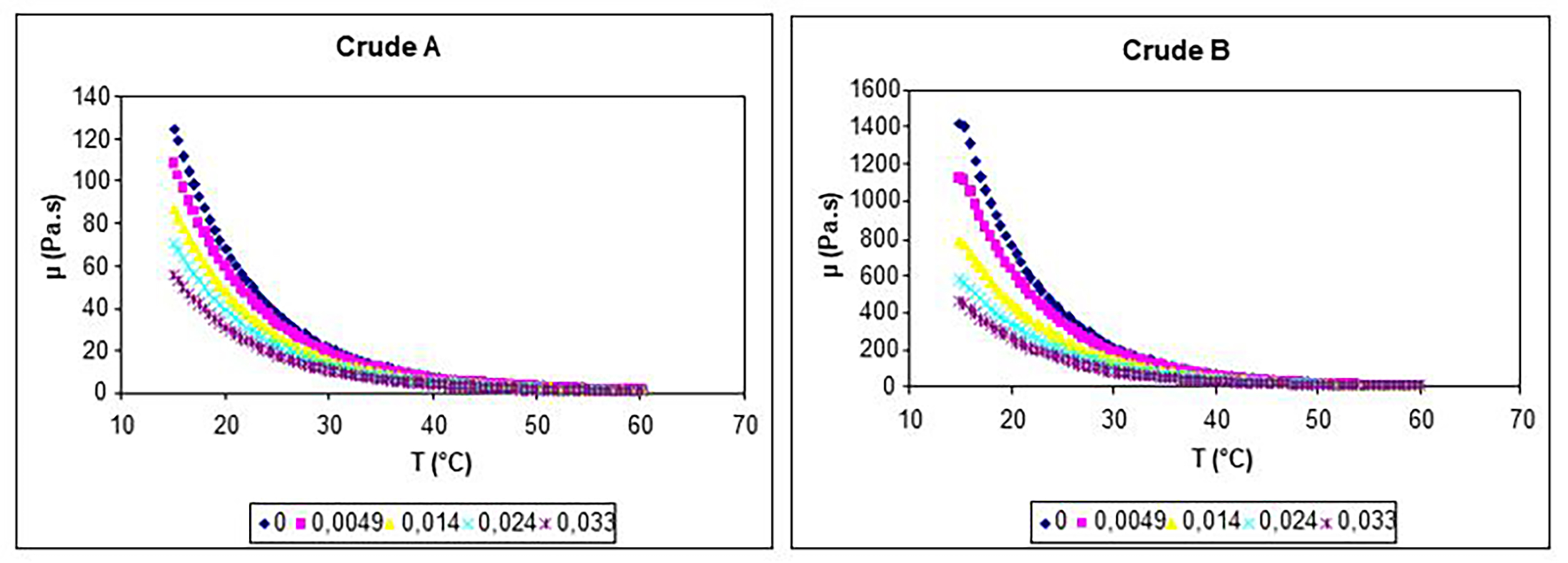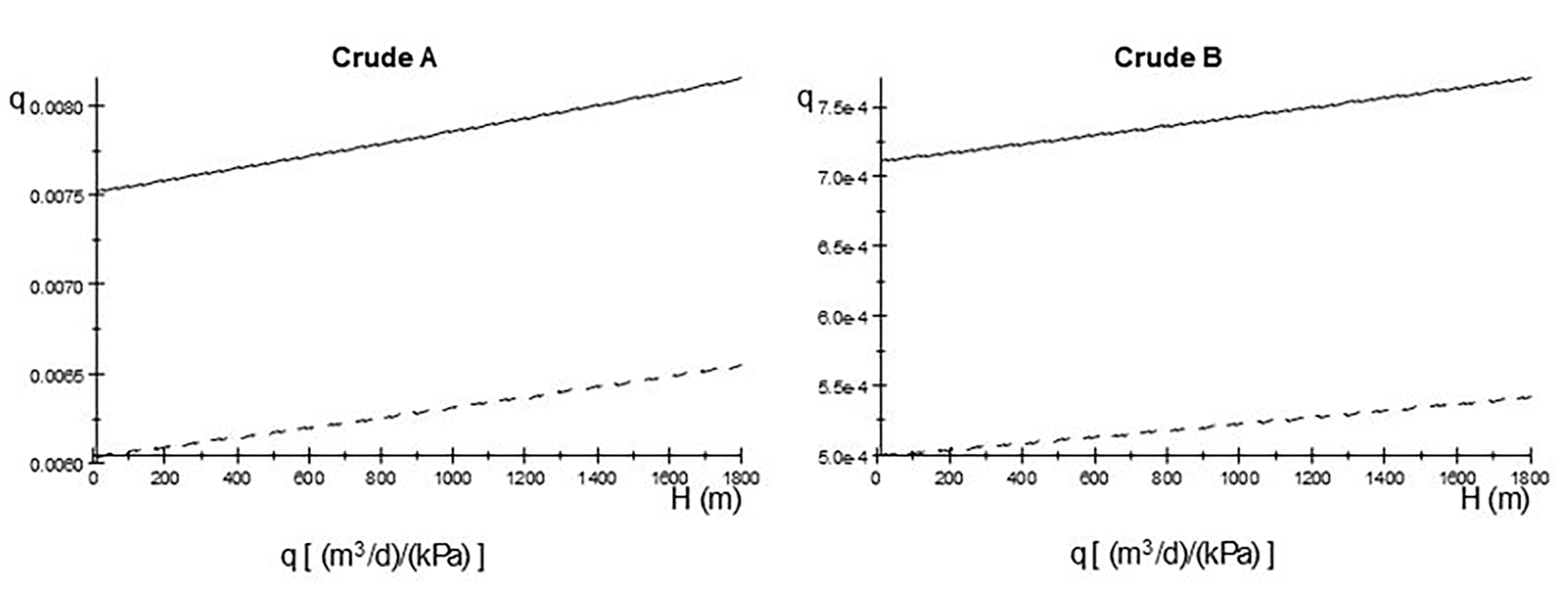Introduction
Heavy crude oils have, in their composition, a considerable fraction of high molecular weight asphaltenes and paraffin molecules (Al-Qasim & Al-Dawsari, 2017; Ilyin et al., 2016; Kumar, Kumar & Singh, 2017; Sama, Barrère-Mangote, Bouyssière, Giusti & Lobinski, 2017). These molecules interact with each other to form aggregates making a dispersed phase that, among other effects, manifests itself in high viscosity (Barnes, 2000; Berg, 2010; Cerbelaud, Laganapan, Ala-Nissila, Ferrando & Videcoq, 2017; Kontogeorgis & Kiil, 2016).
The high viscosity of heavy crude oil leads to an increase in transportation and extraction costs (Ghannam, Hasan, Abu-Jdayil & Esmail, 2012; Santos, Oliveira & Mansur, 2017). Although heating the oil is one of the ways to decrease viscosity, the implementation and operation of the heat transfer systems are associated with high investment and operating costs; therefore, this is not an efficient method in all cases. For this reason, other alternatives have been explored, such as the use of chemicals that act as viscosity reducers without affecting the chemical nature of the crude oil or the consequent refining operations (Ilyin et al., 2016; Pérez-Sánchez, Alarcón-Montelongo, Díaz-Zavala, Palacio-Pérez & Suárez-Domínguez, 2017; Suárez et al., 2016). The physical-chemical action mechanism of improvers depends on the chemical nature of its active ingredient and crude oil composition, as well as the processes that cause high viscosity.
The chemical employed in this work is an enhancer whose active ingredient is an epoxidized ester. Because its polarity, it is established that the enhancer fundamental action mechanism is based on the epoxidized ester-asphaltenes molecular interaction, in such a way that the fraction that forms aggregates decreases (dispersed phase in the crude), with the consequent reduction of viscosity (Rogel et al., 2017). Both crude oil composition and molecular interactions were analyzed to obtain a model that predicts the viscosity behavior concerning the concentration of the enhancer.
This work presents the results observed about the effect of temperature and enhancer concentration on the viscosity of two crude oils (A and B) from the North of Mexico. A mathematical model is presented to describe frictional pressure losses concerning the enhancer concentration in systems in which there exist heat losses through the walls of the pipeline.
Materials and methods
100 mL of each crude was mixed with a known amount of the flow enhancer corresponding to the next volume fractions: 0; 0.0049; 0.014; 0.024; and 0.03380. The behavior of the viscosity was determined in a temperature range between 15 °C and 60 °C with a Brookfield Viscometer, and the experimental results obtained are shown in Figure 1. It can be observed that, for all cases, the viscosity decreases in a non-linear way. In contrast, for a fixed temperature, the viscosity decreases when the volume fraction of the enhancer is increased.

Source: Authors’ own elaboration.
Figure 1 Behavior of viscosity μ (Pa·s) with respect to temperature T (°C) for different concentrations of enhancer expressed as volume fraction for each crude.
Under the hypothesis that the enhancer presence results in a reduction of the volume fraction of asphaltenes, which is the dispersed phase in the crude oil, and that viscosity depends on the value of this fraction, it is a priori to establish the following model to determine the viscosity behavior for temperature and volume fraction of enhancer (Suárez-Domínguez, Pérez-Sánchez, Palacio-Pérez & Izquierdo-Kulich, 2018):
where µ is viscosity (Pa·s), T is the temperature (°C), α n , and β n are parameters adjusted from experimental results, and m is the volume fraction of the enhancer. This hypothesis is supported by the fact that it has been observed that the modifiers of the asphaltenes properties tend to improve the fluidity of the heavy crudes (Guzmán, Ancheyta, Trejo & Rodríguez, 2017; Menapace et al., 2018; Rogel et al., 2017; Sun, Wang, Gu, Xu & Gong, 2017; Zendehboudi et al., 2014).
For each crude, an adjustment of the model given by Equation (1) was performed using the Marquardt statistical method of non-linear regression, with 95% reliability, and using the STATGRAPHICS program. The results are shown in Table 1. In all cases, the estimation was stopped for the residuals sum convergence to adjust the models. The predicted graphs for each of the analyzed models are shown in Figure 2, and the viscosity predicted results concerning the volume fraction of the enhancer, considering temperature as a parameter, are shown in Figure 3.
Table 1 Adjusted parameters (α n and β n), linear correlation factor (R 2 ), and the mean absolute percentage error (MAPE) for each crude.
| Crude | α1 | α2 | α3 | β1 | β2 | R2 | MAPE |
| A | -1.6559 | -513.28 | 37087 | -22.495 | 199.88 | 99.78 | 0.77 |
| B | -7.9987 | -7498.5 | 4.4868x105 | -34.961 | 461.07 | 99.62 | 10.53 |
Source: Authors’ own elaboration.

Source: Authors’ own elaboration.
Figure 2 Comparison between experimental and predicted viscosity results.

Source: Authors’ elaboration.
Figure 3 Predicted viscosity behavior (Pa.s) considering enhancer volume fraction (m) against temperature.
Equation (2) represents the pressure gradient concerning the tube length for the laminar regime of a Newtonian and incompressible fluid (Bird, Stewart & Lightfoot, 2002):
where Q 0 is the flow (m3·s-1), µ is the viscosity (Pa·s), D is the diameter of the tube (m), p is the pressure (Pa), and z represents the length of the tube (m). Equation (2) is valid for isothermal systems and systems in which there are temperature changes along the length z and work with the average temperature of the fluid concerning the flow area. In this case, the viscosity is a function of the temperature gradient against the length of the tube. This gradient is assumed by:
where T 1 and T 2 are the fluid temperatures at the entrance and distance H from the inlet, respectively. The value of H depends on the heat losses through the tube, the temperature at the exit of the well, and the ambient temperature (Suárez et al., 2016). For the conditions T 1 >T 2 and H≤L, where L is the total length of the horizontal tube, and substituting Equation (1) and (3) into Equation (2) (where the overall flow is the mixture of crude plus enhancer), it is obtained the differential equation that describes the behavior of the pressure concerning the length of the tube:
where
The exact analytical solution of Equation 4 is
with the next definition for pressure losses
After mathematical treatment, the pressure losses for a tube of total length L are given by:
where
The behavior of the quotient (q) between the crude flow (Q 0 ) and the pressure losses (∆P) (kPa) for a tube length (L) is determined from Equation 8 and 9 and is given by:
Results
The effect of temperature gradient and flow enhancer concentration on the crude oil production volume was obtained through Equation (10).
For the predictions, it was considered that crude oil is transported by a 10-inch diameter tube and the viscosity values represented by the constants in Table 1. The crude oil inlet temperature was considered for all cases equal to 60 °C, while the value of the ambient temperature was set at 25 °C. Figure 4 shows the quotient (q) between the crude flow and the pressure losses for a length (L) equal to 1000 m from the input and the value of the distance (H), which represents the distance from the inlet for which the crude oil temperature is equal to the ambient temperature. Calculations were performed considering a volume fraction of viscosity reducer (m) equal to 0 (dashed line) and 0.01 (solid line).

Source: Authors’ own elaboration.
Figure 4 The behavior of the quotient (q) between crude oil flow (m3d-1) and pressure drop (kPa) at L = 1000 m for distance (H) (m) with an enhancer volume fraction m of 0 (dashed line) and 0.01 (solid line).
As mentioned, H depends on the temperature difference between ambient and crude oil, and the heat coefficient transfer through the tube wall, which depends on whether any insulating material has been placed to reduce heat losses. In this sense, an increase of this distance is related to a smaller loss of heat to the outside. The model predicts that a higher H value leads to an increase in the flow of crude oil for the same pressure drop. On the other hand, note that for both crude oils, the injection of the viscosity reducer leads to an increase in the flow value, which is the expected result. The predicted results consider that there is a mixture between the chemical and the crude oil. However, these fluids are transported under the laminar regime due to their high viscosity. Therefore, two-phase flow is formed whose pattern will depend on the properties of liquids and injection form.
Conclusions
An experimental study was carried out to analyze the influence of a flow enhancer on the viscosity of heavy crude oil, for which two different crude oils from the Northern region of Mexico were studied. The viscosity behavior of the crude oil concerning temperature was measured for different values of the volume fraction of viscosity reducer, which is mechanically mixed with the crude oil. These results were adjusted by statistical techniques of non-linear regression, with an adequate correspondence between the results observed and those predicted by the adjusted model. By following the influence of the enhancer concentration on crude oil viscosity, a mathematical model is proposed to predict the behavior of the relation between the crude oil flow and pressure drop to a specified length in a hypothetical transport system in which there are losses of heat. For this case, it was obtained that the mixture of crude with enhancer increases the volume of oil achieved at the same value of the pressure gradient.
The results support the hypothesis that viscosity decrease is due to the molecular interactions between asphaltenes and epoxidized ester, which is the active principle of the enhancer. Since both are polar molecules, while the rest of the crude components are non-polar, such interaction leads to a decrease in the fraction of asphaltenes that are in a dispersed phase.
It should be emphasized that the model considers the transport in laminar regime due to their high viscosity with a two-phase flow pattern that depends on the properties of both fluids and the form of injection. In this case, a different mathematical model to predict the behavior of the system must be established.











 nueva página del texto (beta)
nueva página del texto (beta)


